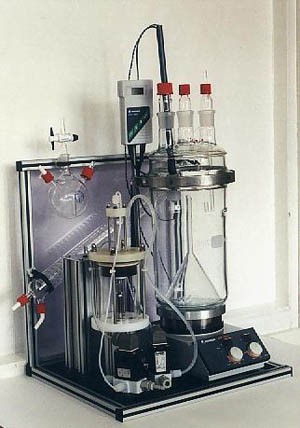Buffer Preparation
FIA manufactures equipment for automated production and handling of pH buffers for dissolution testing of pharmaceutical formulations etc. The equipment can be used for other purposes as well. The Buffer preparator may be used together with a Mobile volumetric dispenser for an effective and working environmental friendly handling See more under our products: Dilution pumps and Volumetric dispensers.
Continuous buffer preparation with degassing
FIA’s On-line buffer preparation unit is especially designed for dissolution tests with a Flow-Through Cell Apparatus (USP Apparatus 4)1, 2. It contains a dilution pump with a fixed ratio and a degasser for the pH-buffer.
In the degasser, the pH buffer is preheated in a countercurrent heat exchanger. It is connected to a glass vessel where the liquid is 80 ºC. When the dissolved gases are “boiled off” the buffer again passes the heat exchanger. Now it is cooled to near room temperature, ready for use in the dissolution equipment.
Different alternative degassers are also available.
Materials and construction
FIA´s buffer preparator is completely free of metal in all components that can come into contact with liquids. FIA uses of glass, plastic and rubber that is resistant to corrosion. It does not contamine the pH buffer with any transition metals that might cause decomposition of sensible pharmaca.
The dilution pump is driven by compressed air, without a PLC or PC. However, it may be computer contolled. An electrically driven variety is available.

Picture 1: FIA’s Automated buffer preparator
About degassing
Briefly:
Degassing is made to avoid that the surface of the tablets entirely or partly becomes covered by air bubbles. Air bubbles retards the dissolution.
The mechanism for the formation of air bubbles is the same as when a glass of cold water is put on the bedside table. As the water slowly becomes warmer, the solubility of air decreases and therefore air bubbles are formed and sticks to the glass surface. After a while, air bubbles covers the iside surface of the glass.
In detail:
Degassing mechanisms are often misunderstood.
Formation of air bubbles depends from the fact that the solubility of air in water is greater at lower than higher temperature. If you heat from room temperature to 37 ºC, the water at first becomes supersaturated. Next, bubbles are formed at high energy points such as unevenness on a glass surface or on the roughness in the surface of a tablet. If they are formed on the surface of the tablet, they will block the surface to water communication and slow down the release of drug.
To avoid the phenomenon you must conditions so that no supersaturation will arise.
The water solution must thus contain less dissolved air than the solulibility permits at a certain temperature. For a dissolution medium it normally means less than can be dissolved at 37 ºC.
One way to do that is to raise the temperature above 37 ºC and then create release of the excess of dissolved gases. The release can be done by application of vacuum, suck the liquid through a glass filter or even whip it with a beater (!). As the temperature again is lowered, the water becomes below the limit of gas saturation and no bubbles may be formed.
It is also possible to apply vacuum on a liquid stream via a membrane that is permeable to gas but not to liquid. This can be made online and the dissolved gases are removed to an extent that formation of bubbles are prevented (http://www.biotech.se/products/degassing-debubbling/).
Degassing with Helium is generally even less understood. Helium has got a very low solubility in water, but the small helium bubbles may effectively imbibe or act as sprouts for the dissolved supersaturated air. Helium degassing must take place above or at the usage temperature of the liquid.
1 Wennergren, B., Lindberg, J., Nicklasson, M., Nilsson, G., Nyberg, G., Ahlgren, R., Persson, C. and Palm, B.: A collaborative in vitro dissolution study: comparing the flow-through method with the USP paddle method using USP prednisone calibrator tablets. Int. J. Pharm., 53 (1989) 35-41.
2 Nicklasson, M., Wennergren, B., Lindberg, J. Person, C., Ahlgren, R., Palm, B., Pettersson, A. and Wenngren, L.: A collaborative in vitro study using the flow-through method. Int. J. Pharm., 37 (1987) 195-202.
